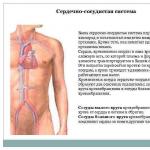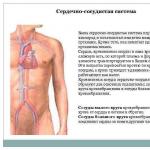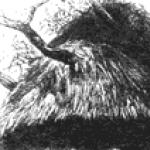Presentation on geography on the topic "Bosnia and Herzegovina" (grade 11). Presentation on the topic "rich and poor countries of Europe" Military tunnel, Sarajevo
1 slide

2 slide
Flag When creating the flag of Bosnia and Herzegovina, the following colors were used: blue, similar to the flag of the European Union. This color and the stars represent Europe, and yellow, the color of the sun, symbolizes hope. This flag of Bosnia and Herzegovina was one of three presented to parliament by the UN Special Representative. All flags used the same colors: blue was the color of the United Nations, but it was replaced by a darker one. The stars represent Europe. The triangle symbolizes the three main population groups of the country (Bosniaks, Croats and Serbs) and the outline of the country on the map.

3 slide
Coat of arms The coat of arms of Bosnia and Herzegovina is the state symbol of Bosnia and Herzegovina, it is a blue shield with a yellow triangle. The triangle symbolizes the country's three main population groups (Muslims, Croats and Serbs) and the outline of the country on the map. White stars symbolize Europe.

4 slide
Anthem The National Anthem of Bosnia and Herzegovina (Intermeco) is the national anthem of Bosnia and Herzegovina. Adopted on June 25, 1999 by the law “On the Anthem of Bosnia and Herzegovina”, replacing the old Jedna si jedina, which was not accepted by the Serbian and Croatian communities of the country. Dusan Shestic wrote the music for the anthem, but the anthem has no words.

5 slide

6 slide
Economy Consists of the autonomous administrative units of the Federation of Bosnia and Herzegovina, the Republika Srpska and the Brcko District. The name of the country comes from the name of the Bosna River and the German title “duke”, which was borne by the voivode Stefan Vukčić Kosača in the 15th century. It borders on the west and north with Croatia, on the east with Serbia, and on the southeast with Montenegro. It has a small access to the Adriatic Sea - about 24.5 km of coastline. Area - 51 thousand square meters. km. Large cities - Tuzla, Banja Luka, Mostar, Zenica, Bihac, Travnik. The monetary unit of Bosnia and Herzegovina is the convertible mark. Bosnia and Herzegovina is located on the territory of two historical regions - Bosnia, which occupies the valley of the Sava River and its tributaries, and Herzegovina, located to the south, in the Neretva River basin. The capital is Sarajevo (about 800 thousand people). The city of Sarajevo was founded in 1263 and then received the name “Bosnovar” (Vrhbosna in Serbian). The city is located in a basin surrounded by mountains and open only on the western side, at an altitude of 450 m above sea level. Two Orthodox churches have been preserved - the old Church of Saints Michael and Gabriel (presumably 1478-1539) and the Cathedral Church of the Holy Mother of God (1863-1868), 4 Catholic churches, including the spiritual center of Bosnian Catholics - the Cathedral (XVIII century) , 3 synagogues, including the Old Synagogue (1566-1581), which now houses the Jewish Museum with the famous "Hagada Code", as well as the Town Hall ("Eternal", 1896) in the Moorish style and the Regional Administration Palace. But the city landscape is dominated by colorful Muslim buildings, most of which are considered masterpieces of Ottoman architecture - the Tsareva-Jamia mosque ("Royal Mosque", 16th century), the largest in the country, "Begova-Jamia" (15th century), Ali- Pasha-Jamia (1560-1561) and about a hundred more mosques, the Kursumli madrasah (1537) with a library, today numbering about 50 thousand manuscripts and books, the Barcharshiya tower (XV century), the Brusa-Bezistan shopping center, the old caravan a barn (15th century) on Morika Khan, a Turkish fortress with 12 towers on a rocky ledge, and many trade buildings of the Turkish era.

7 slide
Traditions The Yugoslav Republic, which became modern Bosnia and Herzegovina, was formed from two historical regions - Bosnia in the north, with its capital in Sarajevo, and Herzegovina in the south, with its capital in Mostar. Other major cities are Banja Luka, Tuzla, and Zenica. The state, located mainly in the Dinaric Highlands, has no coastal ports. The Sava River (and its tributaries) and the Neretva River are the main rivers; There are river ports along the Sava River. Most of the country is forested, and timber is an important product of Bosnia. Most of Herzegovina, on the contrary, does not have much forest cover. Bosnia and Herzegovina has a wonderful and rich cultural heritage. Epic stories told through song are famous throughout Bosnia. The country is also famous for its love songs, which have been sung for generations.
Bosnia and Herzegovina -
state in southeastern
Europe, central part
Balkan Peninsula.
The capital is the city of Sarajevo
(about 300 thousand people).
Is federal
democratic
republic. The name of the country
comes from the name of the river
Bosna and German title
"Duke".
Area - 51 thousand km². The country has a 26-kilometer
access to the Adriatic coast in the city of Neum.
Bosnia and Herzegovina is located almost entirely in
within the Dinaric Highlands. Highest point in
The country is Mount Maglic (2386 meters).
Climate
K L I M ATThe climate is temperate continental. To the characteristic
the characteristics of the local climate include rapid
changes in local weather during the day, which is associated with
various heating of mountain slopes under the influence
sun rays changing their angle of incidence during
day. The average summer temperature in the valleys is from +16 to +27 C, and
up to +10-21 - in mountainous areas. In winter from 0 C to -7 C. Average
the amount of precipitation is 800 mm per year.
State structure
G O S U D A R S T V E N O EDEVICE
Collective head of state -
Presidency of Bosnia and Herzegovina.
Supreme legislative body -
Parliamentary Assembly of Bosnia and
Herzegovina.
The highest executive body
power is the Council of Ministers.
After the war of the early 90s XX
century, the country began to elect three
presidents: one from the Croats,
Serbs and Bosnians. Lead the country
they take turns for 4 years, changing
every 8 months. Administrative division
December 14, 1995 by Dayton
peace agreements were
approved modern
administrative-territorial
division of Bosnia and Herzegovina.
○ Federation of Bosnia and Herzegovina
○ Republika Srpska
○ Brcko District
Industry
INDUSTRYGradually in the country after
Civil War
enterprises are being restored
mining, metallurgical,
oil refining industry,
textile production is growing
industry, components
for automobiles, aviation
industry and household
devices.
GDP per capita: 3,682.27
$ per person
Agriculture
RURALFARM
Agriculture -
main branch of the economy
Bosnia and Herzegovina, despite
on infertile soils.
The main crops are tobacco,
sugar beets, corn and
wheat. Fruits are grown
(plums, figs). Livestock
presented mainly
breeding goats and sheep.
Population
POPULATIONThe country ranks 120th in the world
by population. Before the beginning
military operations (according to the 1991 census
year) the country had a population of 4.36 million
people: Bosnians - 43.6%, Serbs -
31.4%, Croats - 17.3%.
Official languages - Bosnian,
Serbian, Croatian.
Birth rate: 8.8/1000 people;
Mortality: 8.42/1000 people;
Migration: 6.38 / 1000 people.
Religion
RELIGIONConquest of Bosnia by the Turks in the 15th-16th centuries. accompanied
mass conversion of the population to Islam. The Turks announced
that those who converted to Islam received tax exemption
and other privileges.
Currently, commitment to one or another
denomination is determined mainly by nationality: Serbs
- profess Orthodoxy (31%), Croats - Catholicism (15
%). Serbs and Croats who practice Islam call themselves
Bosniaks or Muslims (40%).
Monetary currency
MONEYMain currency in the country
- convertible mark
(equal to 0.51 euro)
CURRENCY
culture
K U L T U RABosnia and Herzegovina from the very
the beginning of existence was
a meeting place for many
crops Before the 1992-1995 war
remained on its territory
many architectural monuments
Byzantine and Ottoman
period. So, in one of
Bosnian cities Banja Luka
remains of Roman baths have been preserved.
National costumes
Armed forces
ARMEDFORCES
Armed forces
Bosnia and Herzegovina
designed to protect
freedom, independence and
territorial integrity
states. Citizens of Bosnia and
Herzegovina males and
over 18 years old are suitable for
voluntary military service.
Number of Armed Forces:
46.00 thousand people (2000)
Winter Olympic Games
WINTER OLYMPICSThe most important international
sporting event in history
Bosnia and Herzegovina was
hosting 14 Winter Olympics
games held in Sarajevo, from 8 to 19
February 1984.
1127 participated in the Olympics
male athletes and 283
female athletes.
GAMES
Sights of the country. Old Bridge.
ATTRACTIONSOLD M O S T.
Old Bridge - pedestrian
bridge over the Neretva river in the city
Mostar 29 meters long and wide
4 meters. The old bridge stood for 427
years until November 9, 1993 during
The Croatian-Bosnian war did not
was completely destroyed.
Cost of restoration in 1998
year exceeded 15 million euros.
COUNTRIES.
Vrelo Bosne Nature Park
NATURALVRELO PARK
BOSNE"
Vrelo Bosne Nature Park
located in the central part
Bosnia and Herzegovina near
Ilidzha village at the foot of the mountain
Igman.
The park was founded during the Austro-Hungarian rule. During
Bosnian War park came to
decline In 2000, thanks to
activities of local activists park
was restored to its original form.
Kravice Waterfall
W O D O F A D K R A V I C EThe Kravice waterfall is located near the village of Studenak. He
rises more than 120 meters and falls from 25 meters into the crystalline
pure natural pool water. Kravice waterfall flows from the crystal
clean river Trebizat (the second largest river in Bosnia and Herzegovina,
length 51 km.).
Slide 2
Flag
When creating the flag of Bosnia and Herzegovina, the following colors were used: blue, similar to the flag of the European Union. This color and the stars represent Europe, and yellow, the color of the sun, symbolizes hope. This flag of Bosnia and Herzegovina was one of three presented to parliament by the UN Special Representative. All flags used the same colors: blue was the color of the United Nations, but it was replaced by a darker one. The stars represent Europe. The triangle symbolizes the three main population groups of the country (Bosniaks, Croats and Serbs) and the outline of the country on the map.
Slide 3
Coat of arms
The coat of arms of Bosnia and Herzegovina - the state symbol of Bosnia and Herzegovina, is a blue shield with a yellow triangle. The triangle symbolizes the country's three main population groups (Muslims, Croats and Serbs) and the outline of the country on the map. White stars symbolize Europe.
Slide 4
Hymn
The National Anthem of Bosnia and Herzegovina (Intermeco) is the national anthem of Bosnia and Herzegovina. Adopted on June 25, 1999 by the Law “On the Anthem of Bosnia and Herzegovina”, replacing the old Jednasijedina, which was not accepted by the Serbian and Croatian communities of the country. Dusan Shestic wrote the music for the anthem, the anthem has no words.
Slide 5
Currency
Convertible mark
Slide 6
Economy
Consists of the autonomous administrative units of the Federation of Bosnia and Herzegovina, Republika Srpska and Brcko District. The name of the country comes from the name of the Bosna River and the German title “duke”, which was borne by the voivode Stefan Vukčić Kosača in the 15th century. It borders on the west and north with Croatia, on the east with Serbia, and on the southeast with Montenegro. It has a small access to the Adriatic Sea - about 24.5 km of coastline. Area - 51 thousand square meters. km. Large cities - Tuzla, Banja Luka, Mostar, Zenica, Bihac, Travnik. The monetary unit of Bosnia and Herzegovina is the convertible mark. Bosnia and Herzegovina is located on the territory of two historical regions - Bosnia, which occupies the valley of the Sava River and its tributaries, and Herzegovina, located to the south, in the Neretva River basin. The capital is Sarajevo (about 800 thousand people). The city of Sarajevo was founded in 1263 and then received the name “Bosnovar” (Vrhbosna in Serbian). The city is located in a basin surrounded by mountains and open only on the western side, at an altitude of 450 m above sea level. Two Orthodox churches have been preserved - the old Church of Saints Michael and Gabriel (presumably 1478-1539) and the Cathedral Church of the Holy Mother of God (1863-1868), 4 Catholic churches, including the spiritual center of Bosnian Catholics - the Cathedral (XVIII century) , 3 synagogues, including the Old Synagogue (1566-1581), which now houses the Jewish Museum with the famous "Hagada Code", as well as the Town Hall ("Eternal", 1896) in the Moorish style and the Regional Administration Palace. But the city landscape is dominated by colorful Muslim buildings, most of which are considered masterpieces of Ottoman architecture - the Tsareva-Jamia mosque ("Royal Mosque", 16th century), the largest in the country, "Begova-Jamia" (15th century), Ali- Pasha-Jamia (1560-1561) and about a hundred more mosques, the Kursumli madrasah (1537) with a library, today numbering about 50 thousand manuscripts and books, the Barcharshiya tower (XV century), the Brusa-Bezistan shopping center, the old caravan a barn (15th century) on Morika Khan, a Turkish fortress with 12 towers on a rocky ledge, and many trade buildings of the Turkish era.
Slide 7
Traditions
The Yugoslav Republic, which became modern Bosnia and Herzegovina, was formed from two historical regions - Bosnia in the north, with its capital in Sarajevo, and Herzegovina in the south, with its capital in Mostar. Other major cities are Banja Luka, Tuzla, and Zenica. The state, located mainly in the Dinaric Highlands, has no coastal ports. The Sava River (and its tributaries) and the Neretva River are the main rivers; There are river ports along the Sava River. Most of the country is forested, and timber is an important product of Bosnia. Most of Herzegovina, on the contrary, does not have much forest cover. Bosnia and Herzegovina has a wonderful and rich cultural heritage. Epic stories told through song are famous throughout Bosnia. The country is also famous for its love songs, which have been sung for generations.
Description of the presentation by individual slides:
1 slide
Slide description:
2 slide
Slide description:
Bosnia and Herzegovina Bosnia and Herzegovina (Bosnian, Serbo-Croatian and Croatian Bosna i Hercegovina, BiH, Serbian Bosna and Herzegovina, BiH) is a state in the central part of the Balkan Peninsula. It is a federal democratic republic consisting of three equal entities: the Federation of Bosnia and Herzegovina, the Republika Srpska and the Brcko District. The name of the country comes from the name of the Bosna River and the German title “duke”, which in the 15th century was borne by the voivode Stefan Vukšić Kosača. It borders on the west and north with Croatia, on the east with Serbia, and on the southeast with Montenegro. It has a small access to the Adriatic Sea - about 24.5 km of coastline.
3 slide
Slide description:
Flag of Bosnia and Herzegovina The flag of Bosnia and Herzegovina was approved on February 4, 1998. This flag of Bosnia and Herzegovina was one of three presented to the parliament appointed by the UN High Representative. All flags used the same colors: blue is the color of the United Nations, but it was replaced by a darker one. The stars symbolize Europe. The triangle symbolizes the country's three main population groups (Bosniaks, Croats and Serbs) and the outline of the country on the map. After the declaration of independence in 1992, the approved flag of the Republic of Bosnia and Herzegovina was a white panel with the coat of arms of the Republic of Bosnia and Herzegovina placed in the center - a blue shield with six golden lilies and a diagonal white stripe. During the Bosnian War, this flag was used by Bosnian Muslims and the RBiH government in controlled territories. Currently, the RBiH flag (popularly known as the “flag with lilies”) is used by Muslim national organizations, football fans of Bosnian nationality, as well as among Bosnian nationalists.
4 slide
Slide description:
Previous flags Flag of the Republic of Bosnia and Herzegovina April 6, 1992 - February 4, 1998 Flag of the SR Bosnia and Herzegovina 1945-1992
5 slide
Slide description:
Flag projects After the Dayton Agreement, the question of choosing a new flag for the country became a question. This was caused by dissatisfaction with the use of symbols of the Republic of Bosnia and Herzegovina by Serbs and Croats, which they considered to represent only Muslims. Among others, the following options were presented: Project 1 “Czech sample” - a flag similar to the flag of the Czech Republic, the colors of which reflect the 3 main nations of Bosnia and Herzegovina. Project 2 The laurel branch on a light blue background, the laurel branch and the color of the flag symbolize the United Nations. Project 3 Contours of the country on a light blue background. Project 4 A red, white and blue flag, similar to the flag of the Republic of the Congo, with a map of the country surrounded by stars on a white stripe. Project 5 The project, which later became the official flag of Bosnia and Herzegovina, also during the selection of the flag by the parliament, the alternative was Project 6 and Project 7. Project 1 Project 2 Project 3 Project 4 Project 5 Project 6 Project 7
6 slide
Slide description:
Coat of arms of Bosnia and Herzegovina The coat of arms of Bosnia and Herzegovina is the state symbol of Bosnia and Herzegovina, is a blue shield with a yellow triangle. The triangle symbolizes the country's three main population groups (Bosniaks, Croats and Serbs) and the outline of the country on the map. White stars symbolize Europe.
7 slide
Slide description:
8 slide
Slide description:
History of the coat of arms Coat of arms of the Socialist Republic of Bosnia and Herzegovina December 31, 1946 Coat of arms of the Republic of Bosnia and Herzegovina (1992-1998)
Slide 9
Slide description:
10 slide
Slide description:
History of the coat of arms Coat of arms of the Croatian Republic of Herzeg-Bosna Coat of arms of the Federation of Bosnia and Herzegovina
11 slide
Slide description:
12 slide
Slide description:
History According to the Byzantine Emperor Constantine Porphyrogenitus, the Serbs appeared in the Balkans in the 1st half of the 7th century. After resettlement to the Balkan Peninsula, the first territorial associations among the Serbs, like most southern Slavs, were zhupas. Zhupas usually occupied areas limited by rivers or mountains. Their centers were fortified settlements or cities. As administrative territorial units, the zhupas later became the solid foundation of the Serbian state. However, the Byzantines called all these lands “Sclavinia”. After the settlement of the Slavs in the Balkans, Byzantine sources contain information about many sclavinia from Thessaloniki to Constantinople, and later about sclavinia located above the cities on the Dalmatian coast. Some time after moving to the Balkans, the Serbs formed several large communities, which then became state entities. Between the rivers Cetina and Neretva was the Principality of Neretlian, which the Byzantines called Pagania. The islands of Brac, Hvar and Mljet also belonged to her. The area between Neretva and Dubrovnik was called Zahumlje. The lands from Dubrovnik to the Bay of Kotor were occupied by Travuniya and Konavle. To the south, to the Boyana River, stretched Duklja, which later became known as Zeta. Between the rivers Sava, Vrbas and Ibar there was Raska], and between the rivers Drina and Bosna - Bosnia. Soon after the resettlement of the Slavs to the Balkan Peninsula, political unions of neighboring zhupas, led by princes or bans (in Bosnia), began to be created. The positions of zhupans, princes and bans gradually became hereditary and assigned to individual wealthy and influential families. The constant struggle and military clashes of these relatively small alliances led to the creation of more extensive territorial associations. All these political entities were under the supreme authority of Byzantium. But their dependence on the empire was small and was limited to the payment of tribute. Recognizing the supreme power of Byzantium, the Serbs were actually independent politically. After the death of the Serbian prince Caslav Klonimirovich, Bosnia fell away from his empire. In 1018 it nominally came under Byzantine rule. At the beginning of the 12th century, part of Bosnia became part of Hungary as a result of wars. The Hungarian king received the title "Ramae rex" (king of Rama, that is, Bosnia), since the state lay mainly in the valley of the Rama River. The King of Hungary appointed his governors (bans) to govern Bosnia. Then, for some time, Bosnia again fell under Byzantine influence, but Ban Kulin of Bosnia at the end of the 12th century again recognized himself as a vassal of the Hungarian king, although he behaved as a fully established independent ruler. He granted trading privileges to merchants from Dubrovnik with a document known as Poveglia bana Kulina, encouraged the migration of craftsmen and artisans from Croatia, supported iron ore mining, etc. In 1203, the Pope called on Kulina and the Bosnian elders of the religious communities to reject Bogomilism and embrace Catholicism. In 1250, after a series of crusades against the Bogomils, Hungary re-subordinated Bosnia. In the 12th century, the Bosnian Banate was formed (from the 14th century a kingdom, including Herzegovina). Since 1463, the territory of Bosnia, and since 1482 - of Herzegovina under the rule of the Ottoman Empire. After the uprising of 1875-1877, it was occupied by Austria-Hungary (annexed in 1908). See "Bosnian Crisis". 1910 - the land statute (Zemaljski statut) was adopted, the Bosnian Sabor (Bosanski sabor) was established - the representative body (parliament) of Bosnia, the Land Council (Zemaljski savjet) - the executive body (government) of Bosnia and district councils (Kotarsko vijeće). Since 1918, part of the Kingdom of Serbs, Croats and Slovenes (since 1929 - Yugoslavia). In 1941, it was occupied by German troops and included in the fascist Independent State of Croatia. During the war of 1941-1945. liberated by the troops of the People's Liberation Army of Yugoslavia under the command of Josip Broz Tito and in November 1945 incorporated into Yugoslavia as a federal republic. In the spring of 1992, it announced its secession from the SFRY. Adopted the official name of the Republic of Bosnia and Herzegovina, and was admitted to the UN in May 1992. In mid-1992, there was a sharp escalation of interethnic tensions, which led to the Bosnian War. On November 21, 1995, peace agreements to resolve the Bosnian conflict were initialed in Dayton (USA). Signed in Paris on December 14, 1995. The official name was changed to Bosnia and Herzegovina. Settlement of South Slavic tribes in 700
Slide 13
Slide description:
State system The collective head of state is the Presidium of Bosnia and Herzegovina, consisting of three members of the state-forming peoples. The term of office of the presidium is 4 years. The competence includes foreign policy issues, the appointment of ambassadors and other international representatives from the country, the presentation of budget proposals to Parliament, and more. The highest legislative body is the Parliamentary Assembly of Bosnia and Herzegovina. It consists of two chambers: the House of Peoples (upper, appointed by the legislative bodies of the constituent entities of the confederation with 5 representatives from each of the three communities) and the House of Representatives (lower, formed by popular vote with 14 representatives from each of the three communities). The highest executive body is the Council of Ministers, which consists of 9 ministries: foreign affairs, security, defense, finance, foreign trade and economic relations, transport and communications, civil affairs, human rights and refugees, justice. The canton's local government body is the assembly (skupština), the canton's executive and administrative body is the government (vlada), the community's local government body is the community council (Općinsko vijeće), the community's executive and administrative body is the head of the community (Načelnik općine). Leading political parties: Social Democratic Party of Bosnia and Herzegovina (national) Workers' Communist Party of Bosnia and Herzegovina (national) Union of Independent Social Democrats (mainly Serbian party), Democratic Action Party (Bosniak party), Party for Bosnia and Herzegovina (mainly Bosnian Party), Croatian Democratic Commonwealth of Bosnia and Herzegovina (Croatian Party), Serbian Democratic Party (Serbian Party), Party of Democratic Progress (Serbian Party). The body of constitutional supervision is the Constitutional Court (Ustavni sud), the highest court is the Supreme Court (Vrhovni sud), the appellate courts are the cantonal courts (kantonalni sudovi), the courts of first instance are the community courts (općinski sudovi). BiH Presidency building





